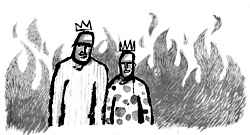A majority of rap music, as long as it’s been around, has been told from the perspective of the young black youth–growing up poor in the hood, amidst chaos, violence, oppression, grief, and pain–where random gunshots are heard at all hours, drug deals go awry, and funeral processions of slain brothers and sisters are the only parades in town. Not the best place for anyone to be, but rappers’ inner-city struggles and triumphs speak directly to those who live it, day in and day out.
Over time, rap music has crossed over to white audiences, appealing primarily to middle-class suburbanites mystified and intrigued by the hard-knock life—nothing they’ve ever experienced. In the documentary Hip Hop: Beyond Beats and Rhymes, which aired recently on PBS, filmmaker Byron Hurt stated that 70 percent of white people listen to rap music. I’m one of them. When I was growing up in rural Humboldt County, Calif., the stories told through rap lyrics were completely foreign and alien to me. I lived as far away from the inner city as one could in the modern world: no cable television, one hour from the nearest full-size grocery store, and over six hours from an established music hub (San Francisco). Though I was far removed from hip-hop culture, let alone a bustling civilization, N.W.A. made their way to my 8-year-old ears via my older brother. The lyrics they spit were about things I’d never experienced (and still haven’t), but it was a pivotal moment as a music fan, and later as a music journalist, that kept me coming back after all these years. Public Enemy taught me young to not believe the hype.
As of lately, the Virginia-based rap duo Clipse, made up of brothers Pusha T and Malice, have been swimming in hype. The longtime allies and former high-school buddies of the Neptunes have been making music together in a world where rap and drugs collide: “I’m from Virginia where ain’t shit to do but cook/Pack it up, sell it triple price/Fuck the books/Where we re-up, re-locate, re-off them brooks/So when we pull up, it ain’t shit to do but look.”
When Clipse finally released Hell Hath No Fury, the long-delayed, much anticipated follow-up to their 2002 debut, Lord Willin’, this past November, I was stunned to see how many critics and bloggers around the country praised it, including Pitchfork, the tastemakers of all things indie rock (which undeniably translates to “white rocker music”). Although I liked Lord Willin’ back when it came out, I really did not want to believe the hype surrounding Hell Hath No Fury. I didn’t bother listening to it until a few weeks ago.
During Clipse’s four-year absence, the landscape of hip-hop and rap music changed dramatically. No longer was rap music primarily an East/West Coast thing. Lil’ Jon placed ATL’s crunk music in the spotlight, Paul Wall and Slim Thug helped Houston’s fertile rap scene explode, and then E-40 put East Bay hyphy on the map. So, where did all this hype for Hell Hath No Fury come from, especially from a whole new breed of white critics?
“Clipse are great writers, are doing some really unique shit, and have an appealing sound, but they’re not really scary dudes,” says music journalist, HoustonSoReal blogger, and promoter Matt Sonzala, who has been involved in the Houston rap scene as long as some of these fresh critics have been able to speak. “I just think a lot of these critics are on a lot of cocaine and identify with that.
“Also, a lot of the kids—the writer kids, the industry kids—when they were starting out, they were laying into the alternative rap tracks, stuff that Def Jux was doing. But the thing is, you don’t get laid listening to that. A lot of these dudes turned their back on Aesop Rock and all that shit that got them into rap in the first place.”
Sonzala, who is white, has a point. People don’t want to nod their heads and be conscious about the “message” anymore. They want to party. Mainstream rap music, for the most part, has become music tailor-made for clubs—where women will shake their asses, and men love it. “You want to party, be around girls, and get laid. I think it has really evolved,” he says. And where there’s a party, there are drugs, something Clipse know about all too well, that critics eat up with a spoon. “A lot of these kids snort a lot of coke. They’re celebrating this shit.”
As for Hell Hath No Fury? The beats are much darker than Lord Willin’, and it isn’t punched with as many singles aside from “Mr. Me Too” and “Wamp Wamp (What It Do)”—which might account for the lackluster sales of the album. But without much radio-friendly fluff or RIAA certification, Clipse do away with that and are able to let off some steam on Hell Hath No Fury, unleashing track after track of pure solid gold.
For once, I should’ve brushed aside my inner Chuck D and actually believed the hype.






